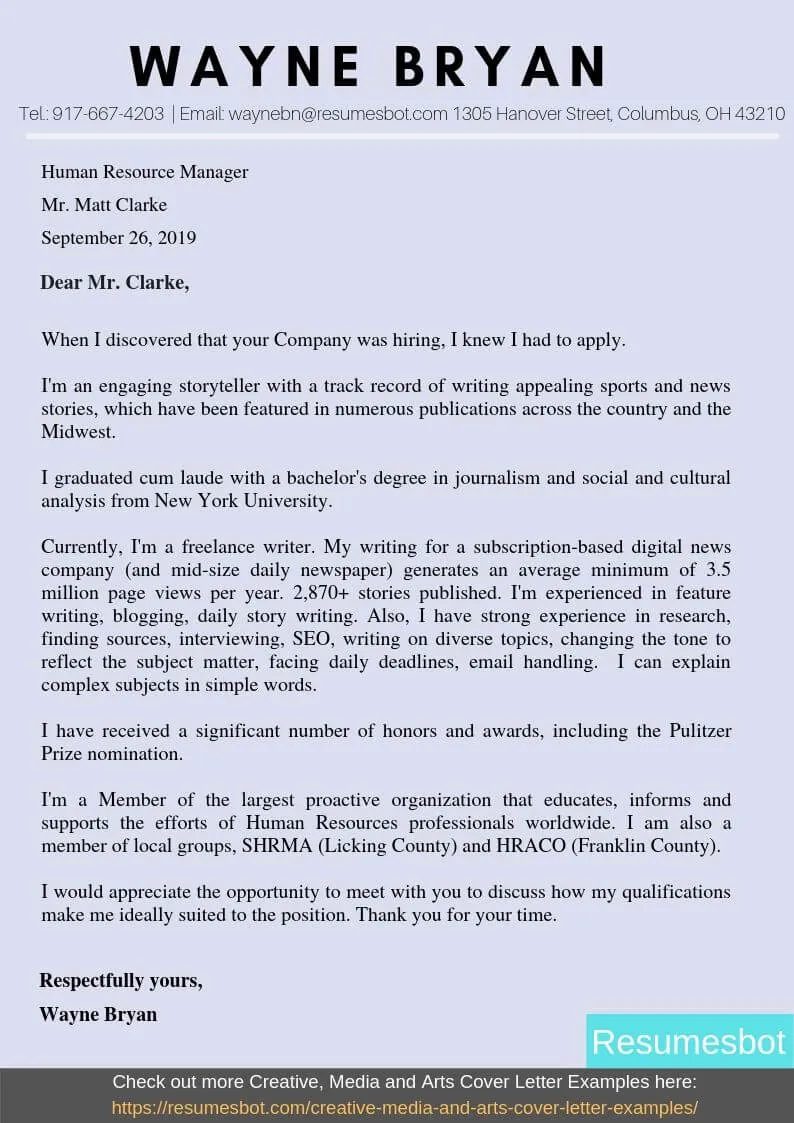As an athlete, you’ve dedicated countless hours to honing your skills, striving for excellence, and achieving remarkable feats. But when it comes to transitioning from the playing field to the professional world, your cover letter is your first and perhaps most important opportunity to make a winning impression. A well-crafted athlete cover letter isn’t just a formality it’s a strategic tool that showcases your unique strengths, experiences, and potential to employers. It’s your chance to demonstrate how the skills you’ve cultivated through sports, such as discipline, teamwork, and resilience, translate into valuable assets in a professional setting. This guide will help you craft an athlete cover letter that captures attention and secures an interview.
Understand the Importance of an Athlete Cover Letter
In a competitive job market, a compelling cover letter for athletes is essential. It’s the initial impression you make on a potential employer, going beyond the basic details of your resume to tell your story and articulate your value proposition. Think of it as your personal introduction, providing context and depth to your qualifications. It’s a space where you can connect your athletic experiences directly to the job requirements, highlighting skills like time management, goal setting, and the ability to perform under pressure. A strong cover letter for athlete’s shows you’re not just skilled on the field, but also prepared, thoughtful, and ready to make a significant contribution to their organization. It demonstrates your ability to communicate effectively, a critical skill in any professional role.
Highlighting Athletic Achievements
Your athletic achievements are a testament to your hard work and dedication. When describing these, be specific and impactful. Instead of simply stating “played on the team,” provide details. Mention any championships won, records broken, or individual awards received. These accomplishments demonstrate your commitment to excellence and your ability to perform at a high level. Use action verbs to describe your achievements, such as ’led,’ ‘achieved,’ ‘won,’ or ‘surpassed.’ The goal is to showcase your successes as clear evidence of your capabilities. This section of your athlete cover letter is where you can truly shine, showing potential employers the concrete results of your efforts.
Quantifying Your Success
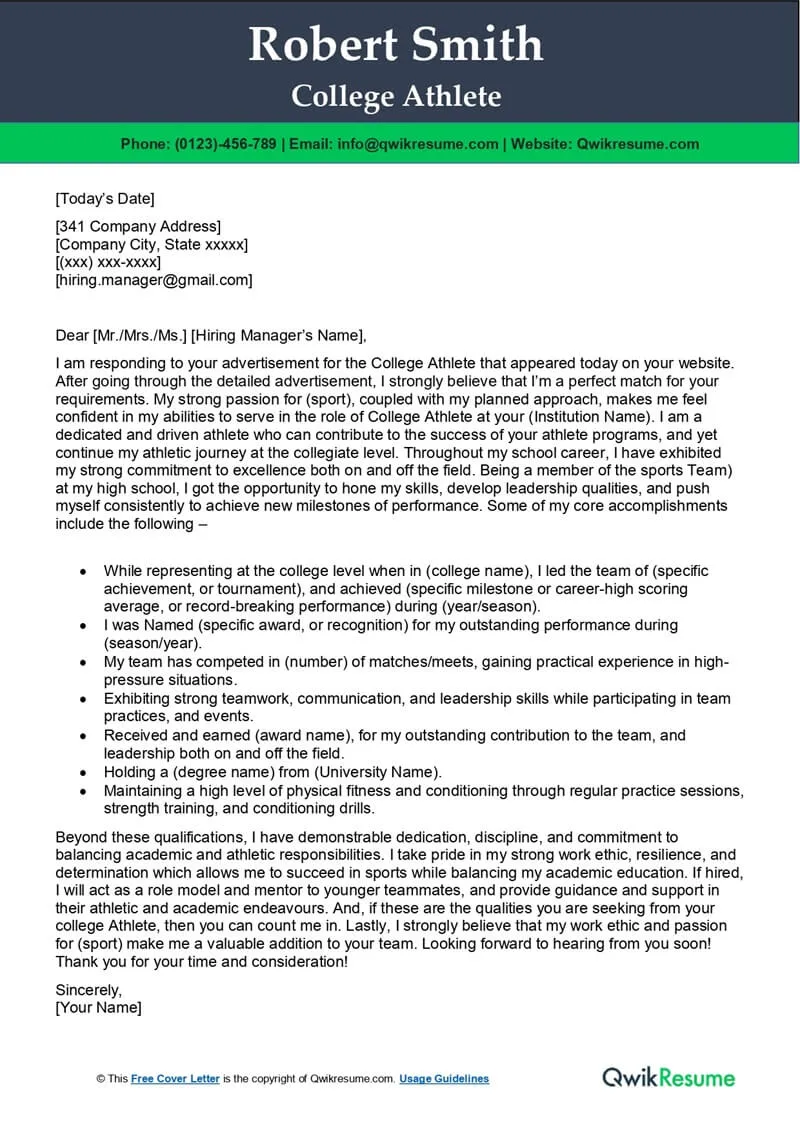
Quantifying your athletic achievements adds significant credibility to your claims. Whenever possible, use numbers to illustrate your success. For example, instead of saying ‘improved my performance,’ state ‘increased my average points per game by 15% over the season.’ Similarly, if you were part of a winning team, mention the win-loss record. Did you break any records or achieve personal bests? Include these details. Numbers make your accomplishments more tangible and easier for the reader to understand the scope of your abilities. This approach underscores your ability to set and achieve measurable goals, a crucial skill in any profession.
Demonstrating Leadership Skills
Athletes often develop strong leadership skills through their team experiences. If you’ve served as a captain, team leader, or held any other position of responsibility, be sure to highlight this. Describe your responsibilities and what you accomplished in these roles. Did you motivate teammates, resolve conflicts, or develop strategic plans? Provide specific examples to illustrate how you led your team to success. Leadership isn’t just about holding a title; it’s about the actions you take and the impact you have on others. In your athlete cover letter, show how you inspired, guided, and supported those around you to achieve common goals.
Providing Concrete Examples
Concrete examples are essential when demonstrating your leadership skills. For instance, instead of saying ‘I improved team morale,’ explain how you achieved it. Did you organize team-building activities, implement new training strategies, or provide individual support to team members? Describe the specific actions you took and the positive outcomes that resulted from them. Did team performance improve? Did team members become more motivated and engaged? Providing examples makes your claims more believable and memorable, showing potential employers that your leadership skills are not just theoretical but proven through your actions. Use the STAR method (Situation, Task, Action, Result) to structure your examples for maximum impact.
Showcasing Teamwork and Collaboration
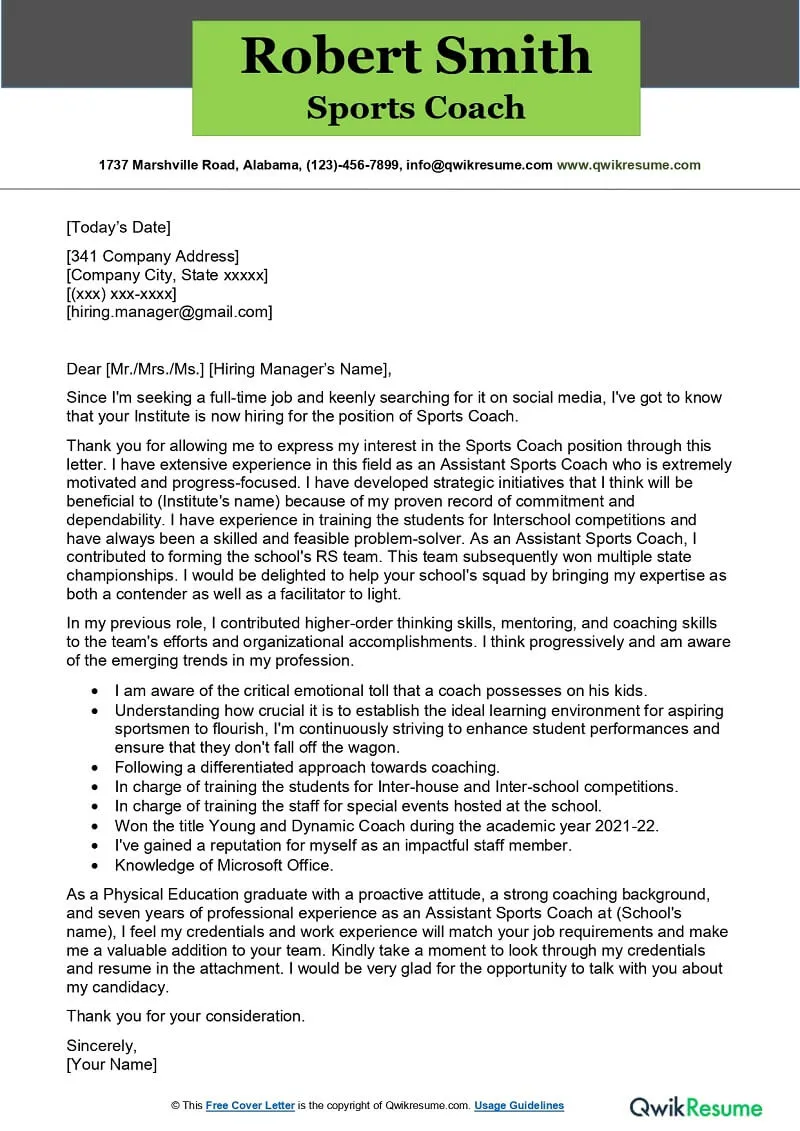
Teamwork is at the heart of almost every sport. In your athlete cover letter, emphasize your ability to work collaboratively towards a common goal. Describe how you’ve contributed to team success and what role you played within the team dynamic. Highlight your ability to communicate effectively, support your teammates, and resolve conflicts constructively. Mention instances where you put the team’s needs above your own individual achievements. Illustrate your understanding of the importance of cooperation and how you work with others to achieve shared objectives. Your ability to be a team player is a valuable asset in any professional environment, and your cover letter is the ideal place to showcase this skill.
Emphasizing Relevant Skills and Experience
While athletic achievements are important, focus on the skills and experiences that are directly relevant to the job you’re applying for. Identify the key skills listed in the job description and connect those to your athletic background. Skills like discipline, time management, resilience, and the ability to perform under pressure are highly transferable. Think about how your athletic experiences have prepared you for the specific demands of the job. For example, if the job requires working under tight deadlines, you might describe how you consistently met training schedules and competition deadlines. The goal is to show the employer that your athletic background has equipped you with the skills necessary to excel in their company.
Tailoring Your Letter to the Specific Role
Customizing your athlete cover letter for each job is crucial. Avoid sending a generic letter; instead, carefully review the job description and tailor your letter to match its specific requirements. Highlight the skills, experiences, and achievements that are most relevant to the role. Demonstrate that you understand the job and the company’s needs. Tailoring shows the employer that you’ve taken the time to understand their organization and that you’re genuinely interested in the position. Mention the specific skills or qualifications they are looking for and explain how your experience aligns with their needs. This personalized approach significantly increases the likelihood of your cover letter standing out.
Researching the Organization
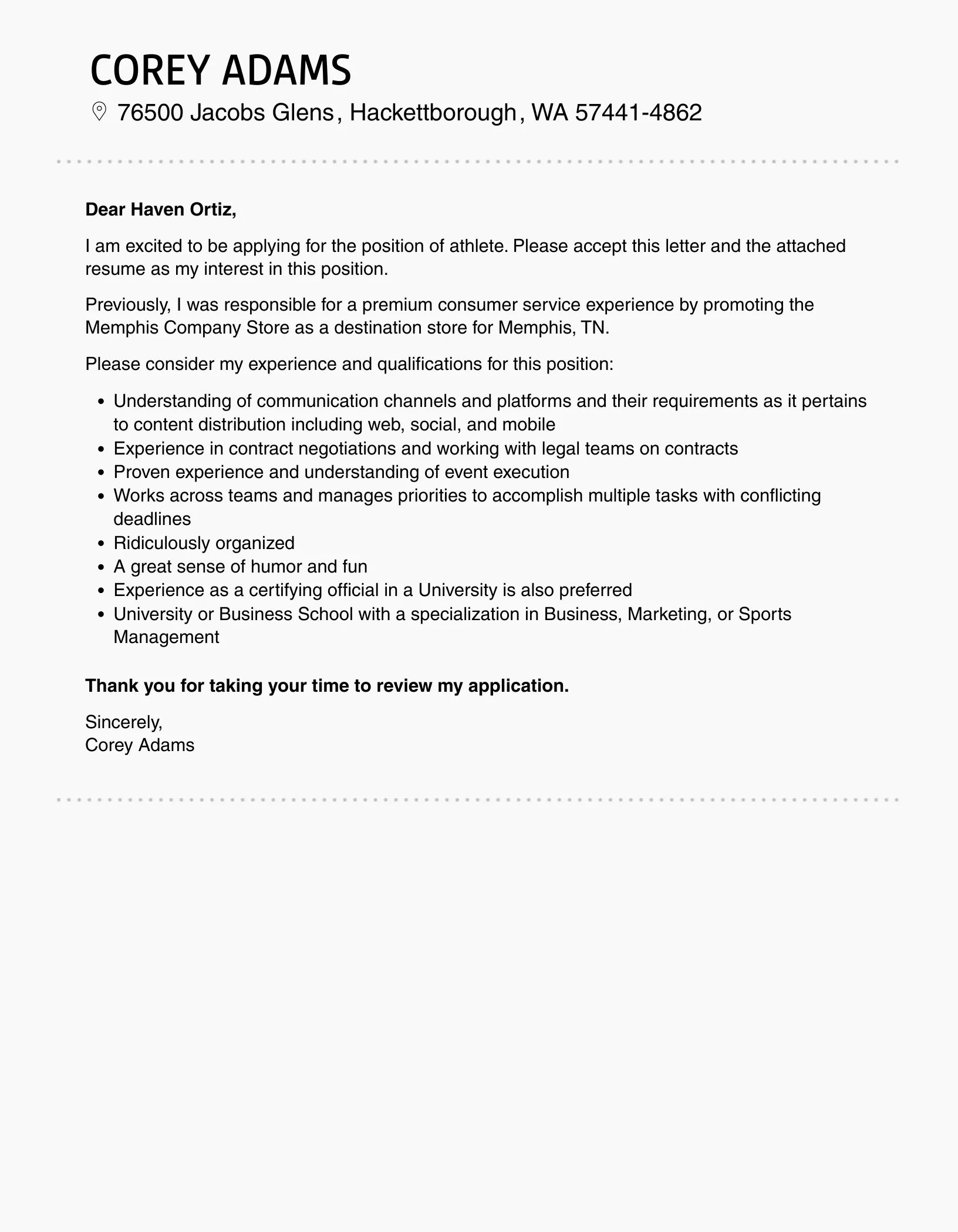
Before writing your athlete cover letter, conduct thorough research on the organization. Understand the company’s mission, values, and culture. Visit their website, read industry news, and review their social media profiles. This research will help you tailor your letter to demonstrate a genuine interest in the organization and their specific needs. Mention any recent company projects, initiatives, or values that resonate with you. Show how your skills and experiences align with the organization’s goals and how you can contribute to their success. Understanding the organization’s culture allows you to tailor your letter to show that you are a good fit.
Matching Skills to Job Requirements
Carefully review the job description and identify the key skills and qualifications the employer is seeking. Then, match your skills and experiences to those requirements. Use the same keywords and phrases from the job description in your athlete cover letter to demonstrate that you possess the necessary skills. For example, if the job requires ‘strong communication skills,’ provide examples of how you’ve effectively communicated with teammates, coaches, or other stakeholders. If the job description mentions ‘problem-solving abilities,’ illustrate how you’ve overcome challenges in your athletic career. By aligning your skills with the job requirements, you demonstrate your suitability for the role and increase your chances of getting hired.
Presenting a Professional and Polished Image
Your athlete cover letter should be a reflection of your professionalism. Ensure it is well-written, free of grammatical errors, and formatted neatly. Use a professional tone and avoid slang or overly casual language. Your cover letter is your introduction to the employer, and it should create a positive first impression. Pay attention to the overall design of the letter. Choose a clean, easy-to-read font and maintain consistent formatting throughout. Make sure your cover letter is concise and to the point, highlighting the most relevant information without unnecessary fluff. This is where your attention to detail shines.
Formatting and Design
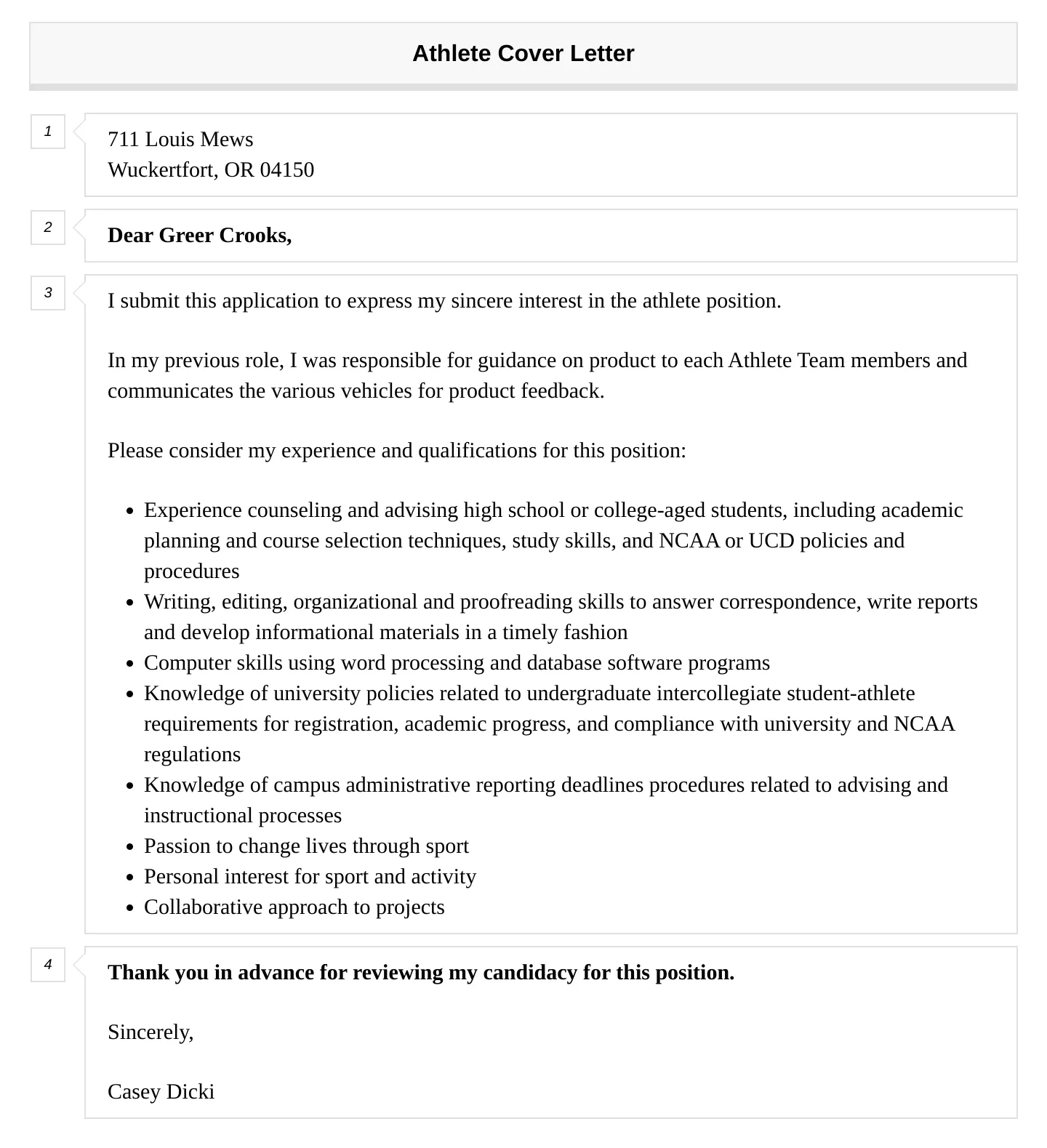
The formatting and design of your athlete cover letter are important aspects of making a winning impression. Use a clear, professional font such as Arial, Times New Roman, or Calibri. The font size should be between 11 and 12 points for easy readability. Use single-spacing within paragraphs and double-spacing between paragraphs. Ensure the letter is well-structured with clear headings and subheadings to guide the reader. Keep the margins at one inch on all sides. Avoid excessive use of bolding, italics, or underlining, as this can make the letter look cluttered. Maintain a professional and balanced layout that is visually appealing and easy to read. A well-designed cover letter demonstrates that you are organized and detail-oriented.
Proofreading and Editing
Proofreading and editing your athlete cover letter is a critical step in the writing process. Errors in grammar, spelling, and punctuation can undermine your credibility. Carefully review your letter multiple times, looking for any mistakes. Consider asking a friend, family member, or career advisor to proofread your letter as well. They can often catch errors that you might have missed. Read the letter out loud to check for awkward phrasing or unclear sentences. Ensure your cover letter flows well and that your ideas are presented in a logical and coherent manner. A polished, error-free cover letter shows that you pay attention to detail and value quality. This will help you win at first glance.
In conclusion, an athlete cover letter is your opportunity to showcase how your athletic achievements and skills make you a strong candidate for a professional position. By highlighting your accomplishments, quantifying your successes, emphasizing relevant skills, and tailoring your letter to the specific role, you can create a compelling cover letter that captures the employer’s attention. Presenting a professional and polished image through impeccable formatting and proofreading is essential. By following these guidelines, you can win at first glance and increase your chances of securing an interview, and ultimately, your dream job. Go forth, athletes, and write your winning cover letter!
